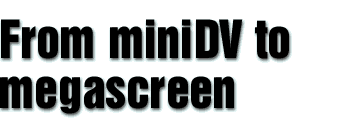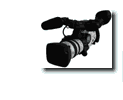|
 |
||
|
Fred Weinel of Colour Video Services explains how to shoot in DV and transfer to film with the best results |
Cinema was born out of film and television from video, each serving its own audience with its own image experience. While they are different there is some cross fertilisation. Film for television is now commonplace, but what of the other direction? Video for the film domain has gone beyond recording for archives, it now brings video originated commercials to the cinema screen and provides a service for budget video originated productions destined for big audience viewing. Indeed, high resolution transfers have a creative role using electronic cinematography to bring special effects to feature films. Such effects we have never seen before and are bounded only by the imagination.
Tape to film transfer is part of this scene. Where video production is required on film for festivals and non theatrical outlets, then tape to film transfer can fulfill that need. Indeed, some producers recognise that the medium has a quality and feel of its own. The medium uses video and film characteristics to produce a unique ‘look’ which can be used to capture what the producer sees as special.
The cost of transfer while not cheap, is efficient. All the programme material ready edited and graded goes 100% to film. Savings therefore can be redeployed in video and post production.
Transfers can be made from videotape to 16mm and 35mm film. In order to maintain resolution it is recommended that Dl or Digibeta be utilised as the edited master for transfer. While the TV frame fits onto an academy film frame, widescreen formats are commonly used in the cinema. The TV 16:9 aspect ratio is only slightly oversize for the cinema 1:1.85 screen and so 92% of the active lines will reach the projection screen. This widescreen format is achieved without DVE, some of which introduce objectionable artifacts.
There are many systems for image capture available today, ranging from Digibeta 16:9 to mini DV. All these can be converted to film. Each has its own typical and preferred application. With all these the exposure rules apply. There is no substitute for looking at your picture on the biggest monitor possible to see what you are likely to see on the film transfer and detect any defects.
The resolution of cameras and the TV system is limited. For productions made specifically for tape to film transfer best results come from the use of medium and close up shots. Longshots and landscapes do not compare well with those photographed on original film. Saturated colour sequences can look soft since the colour resolution of TV system is often at least half that of the luminance part of the signal. Most of the definition is incorporated into the luminance.
Best pictures come from adherence to the common rules of exposure which apply to most images...
Full article published in Filmwaves - Issue 7, Spring 1999. Subscribe now!
